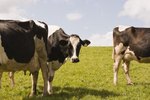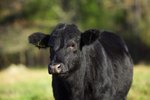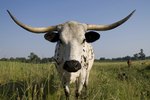With stats that compare to celebrity athletes, breeding rodeo bulls -- also known as bucking bulls -- has become a multimillion-dollar enterprise. Gone are the days of domestic rodeo bovines such as Herefords and Angus; in this modern age you're more likely to find a jumbled genetic stream dedicated less to one breed, and more to one purpose: bucking.
From Nurture to Nature
Originally a Mexican tradition, the Texas Rangers took on the sport of bull riding in 1852. The pastime, although popular, lacked organization and rules until 1936, when the first association of cowboys and bull riders was created. Bulls used then were simply those that displayed ornery personalities and had the propensity to buck.
Over time, the traditional European cattle such as Angus, Herefords and Holsteins were eschewed for far more feisty breeds of bulls: Most current rodeo bulls can trace their heritage back to Texas longhorn and Brahman cattle. No one or two particular breed of cattle produces dependable buckers; although "Plummers" -- an exact half-longhorn and half-Brahman bull-- and "Charbrays" -- Charolais and Brahman -- are popular crosses.
Crafting a King
In pursuit of the perfect bucker, breeders will utilize the best genetic technologies science can offer. Most breeders in the business of rodeo bulls depend upon artificial insemination, pairing renowned buckers with cows sporting distinguished -- and pricey -- bloodlines without the two animals even meeting in person.
Breeders look for bulls that kick high, spin quickly and weigh close to a ton in sheer muscle. When it comes to copying the award-winning moves of previous celebrity bulls, they aren't afraid to follow that course literally: Panhandle Slim, a World Champion rodeo bull has been cloned four times, each genetic copy producing the same bucking pattern as the original bull.
Bulls designed through genetic engineering are known as "born-to-buck" bulls, with some offering nearly $500,000 for a proven bucking bull from royal bloodlines, and around $2,000 per tablespoon of genetically valuable semen.





